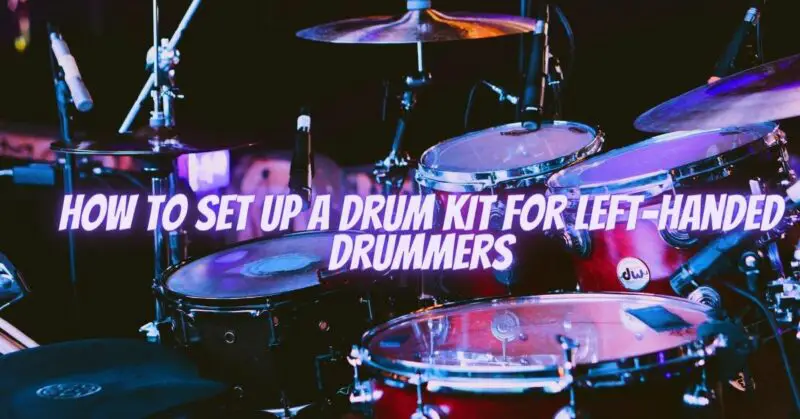Being a left-handed drummer comes with its own set of challenges and adjustments. One of the key considerations for left-handed drummers is setting up the drum kit to suit their playing style and comfort. In this article, we will guide you through the process of setting up a drum kit specifically tailored for left-handed drummers, ensuring a customized playing experience that enhances your drumming skills and musical expression.
- Reversing the Drum Set: The most significant adjustment for left-handed drummers is reversing the setup of the drum kit. Here’s a step-by-step process to reverse the drum set:
a. Position the Drum Throne: Begin by placing the drum throne in the center of the drum kit. Adjust the height to ensure a comfortable and ergonomic seating position.
b. Reverse the Drum Shells: Take each drum shell, including the bass drum, tom-toms, and floor tom, and reposition them in mirror image to their standard right-handed configuration. This means moving the tom-toms from the right side to the left, and vice versa.
c. Reverse the Cymbal Stands: Flip the cymbal stands to accommodate the reversed drum set. The hi-hat stand should now be positioned to the right of the snare drum, and the crash cymbal stand on the left.
d. Adjust the Hi-Hat and Bass Drum Pedals: Reverse the positioning of the hi-hat pedal and the bass drum pedal to match the new drum set arrangement.
- Reorienting the Drum Hardware: To further optimize the setup for left-handed drummers, consider the following adjustments:
a. Hi-Hat Stand: Rotate the hi-hat stand so that the pedal faces the left side, allowing your left foot to control the hi-hat cymbals while your dominant hand plays the snare drum.
b. Snare Stand and Tom Mounts: Adjust the snare drum stand and tom mounts to accommodate the reversed drum set configuration. Ensure that the snare drum is positioned within comfortable reach for your left hand.
c. Cymbal Placement: Position the crash cymbals and ride cymbal within easy reach of your left hand. Experiment with different angles and heights to find the most comfortable and accessible positions for your playing style.
- Adjusting Drum Throne and Seat Height: Ensure that your drum throne is set at the appropriate height for your comfort and playing technique. Adjust the seat height to allow for proper leg positioning and balance. Your thighs should be parallel to the ground, and your knees should be at a 90-degree angle when your feet are on the pedals.
- Customizing Drumstick Selection: As a left-handed drummer, you may prefer drumsticks designed specifically for left-handed players. These sticks are slightly angled or tapered to accommodate the natural motion and grip of a left-handed drummer. Experiment with different stick sizes, lengths, and tip shapes to find what suits your playing style and comfort.
- Ergonomic Considerations: Consider the ergonomic aspect of your drum kit setup. Ensure that your arms, wrists, and shoulders are in a relaxed and comfortable position when reaching for the drums and cymbals. Make adjustments to drum and cymbal heights, angles, and distances to minimize strain and optimize your playing posture.
- Personalize Your Setup: Don’t be afraid to experiment and personalize your drum kit setup based on your preferences and musical style. Fine-tune the positioning of each drum and cymbal to achieve optimal reach and playability. Remember that everyone’s body and playing style are unique, so feel free to adapt the setup to your individual needs.
- Practice and Adaptation: Setting up a drum kit for left-handed drummers is just the starting point. Regular practice and adaptation are essential to become comfortable and proficient with the reversed setup. Focus on developing coordination, limb independence, and a strong sense of timing to make the most of your customized drum kit.
Conclusion: Setting up a drum kit for left-handed drummers requires reversing the arrangement of the drums, cymbals, and hardware to match your dominant hand and foot. By following the steps outlined in this article and making necessary adjustments to accommodate your left-handed playing style, you can create a drum kit setup that enhances your comfort, accessibility, and overall playing experience. Remember to personalize the setup based on your preferences and ergonomic considerations. With practice and adaptation, you’ll find yourself confidently navigating the reversed drum kit, unlocking new possibilities in your drumming journey.

